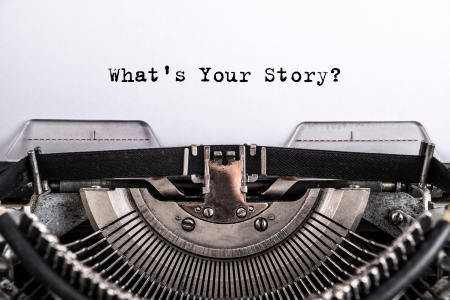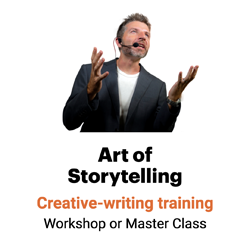Narrative is a powerful communication tool
When you read this passage, can you feel your brain lighting up?

“He’ll hit us! We’d better climb this hillside — and fast!” Frank exclaimed, as the boys brought their motorcycles to a screeching halt and leaped off.
“On the double!” Joe cried out as they started up the steep embankment.
When you read these opening lines of The Tower Treasure, a Hardy Boys novel first published in 1927, different parts of your brain activate to supply different elements of the story:
Your brain lights up when reading stories.
- One group of neurons lights up to provide the story’s sense of space and movement (the careening car on a narrow road).
- Motor neurons flash when the characters clutch the grips or otherwise grasp objects.
- Neurons involved in eye movement activate when characters navigate their world.
- Yet another group of neurons ramps up when you read about the characters’ goals (climbing to safety).
Or so say Jeffrey Zacks and his team of psychologists at Washington University in St. Louis. They used a brain scanner to see which regions lit up as participants read different parts of a story.
“I like a good story well told. That is the reason I am sometimes forced to tell them myself.”
— Mark Twain
“If you pick up a can of soda, your brain goes through a whole cascade of processes having to do with the motor commands to your arms,” Zacks says. “What it looks like to grab the soda can, what it feels like in your hand and arms. …
“And what we found is that as people are lying in the scanner reading about picking up a can of soda …, their brain processes differ in ways that are similar to the differences that we see in responses to real experiences.”
Why is storytelling important? Because stories:
1. Grab and keep audience attention.
Each day, Americans face the data equivalent of 174 newspapers, ads included.
In this environment, communicators must work hard to grab and keep our audience members’ attention. One way to do that is through storytelling.
Consider NPR’s “driveway moments” — stories that are so interesting, they compel their listeners’ rapt attention, no matter what else is competing for their time. The ice cream may be melting, the babysitter may be waiting … but NPR has your attention until the very end of the piece.
Plus, stories transport readers.
2. Make messages easier to understand.
Stories are concrete. They transform abstract concepts — such as the benefits of your products or services — into real-life, human examples that readers can wrap their minds around. That makes stories easier to understand than piles of facts.
When people are confused by information, they turn to stories. When readers face complicated financial data, for instance, they often make up scenarios to help them “see” the topic in action, according to a study conducted at Carnegie Mellon University. That helps readers understand the facts.
In another study, participants who were given a story got the highest scores ever recorded on the Wason Selection Test, one of the most famous tests of detective reasoning. Fewer than 10% of people pass the test. But when the researcher turned the test into a mystery story and transformed participants into amateur detectives, or characters within the story, 70% to 90% of participants passed the test.
3. Increase credibility.
It’s counterintuitive but true: People believe information more readily if it’s delivered in a story rather than through statistics, according to Peg C. Neuhauser’s Corporate Legends and Lore.
Why?
- Readers connect with the people in stories. Call it the Peer Principle of Persuasion: People believe that if something worked for someone else, it will work for them, too.
- Readers are cynical about numbers. Audience members know that organizations can twist numbers to say whatever the organization wants them to say.
But that doesn’t mean it never makes sense to use statistics. In fact, one very credible combination is to:
- Lead with an anecdote that illustrates your point.
- Follow up with a statistic that demonstrates the scope of the issue.
Stories told with statistics make both more powerful.
4. Engage readers.
Readers are far from passive consumers of stories. Indeed, when the story is vivid enough, our brains behave more like they’re acting than reading. That makes reading a dramatic narrative more like imagining a vivid event — or even remembering a real-life experience.
“When they’re reading the story, they’re building simulations in their head of events that are described by the story,” Zacks says. “And so, there’s an important sense that as they build that simulation that it’s significantly like being there.
“We’re used to thinking that virtual reality is something that involves fancy computers and helmets and gadgets. But what these kind of data suggest is that language itself is a powerful form of virtual reality, that there’s an important sense in which when we tell each other stories that we can control the perceptional processes that are happening in each other’s brains.”
No wonder readers understand vivid stories faster and remember them longer.
5. Makes messages more memorable.
Storytelling makes readers more likely to:
- Remember what they’ve read
- Act on the information
- Make good decisions based on the information
That’s according to research by University of Oregon professors Judith Hibbard and Ellen Peters. They found that narrative was more effective than:
- Charts
- Tables
- Graphs
- Simple assertions
And negative stories outperform positive ones, according to the study.
6. Goes viral.
Want readers to spread the word about your story? Awe-inspiring stories and narratives are more likely to get shared.
7. Move people to act.
Storytelling changes jurors’ minds, helps people decide and moves people to give to charity, according to the research.
Why storytelling?
Storytelling is “the most powerful form of human communication,” according to Neuhauser.
Are you crafting stories that get your audience members to pay attention, understand, remember and act on your messages?
___
Sources: “Reading Creates ‘Simulations’ In Minds,” NPR, Jan. 31, 2009
Roger Dooley, “Your Brain on Stories,” Neuromarketing, Jan. 21, 2010
Wray Herbert, “The Narrative in the Neurons,” We’re Only Human, Association for Psychological Science, July 14, 2009
Judith H. Hibbard and Ellen Peters, “Supporting Informed Consumer Health Care Decisions: Data Presentation Approaches that Facilitate the Use of Information in Choice,” Annual Review of Public Health, vol. 24, 2003

Leave a Reply